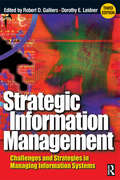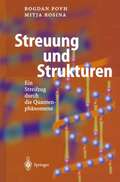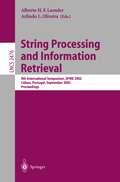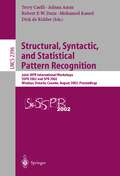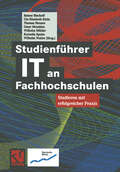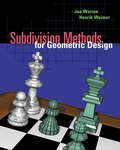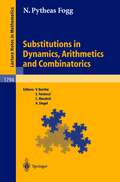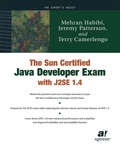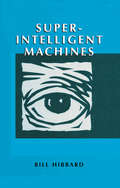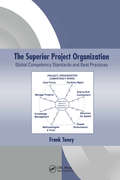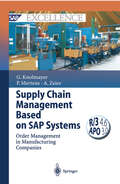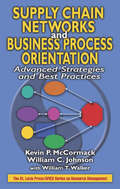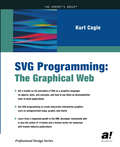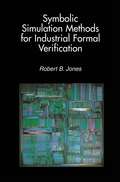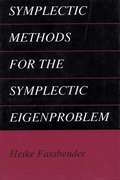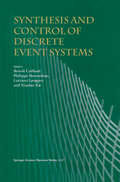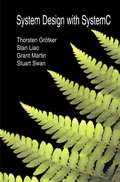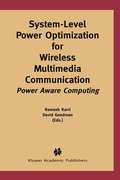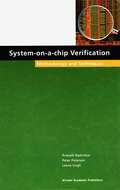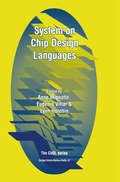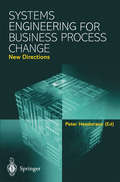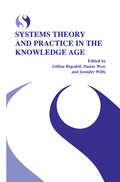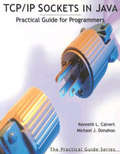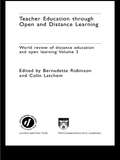- Table View
- List View
Strategic Information Management
by Robert D. Galliers Dorothy E Leidner'Strategic Information Management' has been completely up-dated to reflect the rapid changes in IT and the business environment since the publication of the second edition. Half of the readings in the book have been replaced to address current issues and the latest thinking in Information Management. It goes without saying that Information technology has had a major impact on individuals, organizations and society over the past 50 years or so. There are few organizations that can afford to ignore IT and few individuals who would prefer to be without it. As managerial tasks become more complex, so the nature of the requiredinformation systems (IS) changes - from structured, routine support to ad hoc, unstructured, complex enquiries at the highest levels of management.As with the first and second editions, this third edition of 'Strategic Information Management: Challenges and strategies in managing informationsystems' aims to present the many complex and inter-related issues associated with the management of information systems. The book provides a rich source of material reflecting recent thinking on the key issues facing executives in information systems management. It draws from a wide range of contemporary articles written by leading experts from North America and Europe.'Strategic Information Management' is designed as a course text for MBA, Master's level students and senior undergraduate students taking courses in information management. It provides a wealth of information and references for researchers in addition.
Streuung und Strukturen: Ein Streifzug durch die Quantenphänomene
by Bogdan Povh Mitja RosinaQuantenphysik mag kompliziert erscheinen, wenn man durch Details den Blick auf größere Zusammenhänge verliert. Sie wird einfach, wenn man durch Anwendung weniger grundlegender Konzepte ein Prinzip offenlegt und Größenordnungen abschätzt. Die Eigenschaften von Quantensystemen (Elementarteilchen, Nukleonen, Atome, Moleküle, Quantengase, Quantenflüssigkeiten und Sterne) werden mit Hilfe elementarer Konzepte und Analogien zwischen diesen Systemen dargestellt. Die Wahl der Themen entspricht dem Themenkatalog für die mündliche Diplomprüfung. Das Buch ist vor allem als Vorbereitung auf die mündliche Diplomprüfung gedacht. Einige der Kapitel sind jedoch weit über den Rahmen des Prüfungsniveaus ausgebaut worden, so daß das Buch auch für fertige Physiker von Interesse sein sollte.
String Processing and Information Retrieval: 9th International Symposium, SPIRE 2002, Lisbon, Portugal, September 11-13, 2002 Proceedings (Lecture Notes in Computer Science #2476)
by Alberto H. F. Laender Arlindo L. OliveiraThis volume of the Lecture Notes in Computer Science series provides a c- prehensive, state-of-the-art survey of recent advances in string processing and information retrieval. It includes invited and research papers presented at the 9th International Symposium on String Processing and Information Retrieval, SPIRE2002, held in Lisbon, Portugal. SPIREhas its origins in the South Am- ican Workshop on String Processing which was ?rst held in Belo Horizonte, Brazil, in 1993. Starting in 1998, the focus of the workshop was broadened to include the area of information retrieval due to its increasing relevance and its inter-relationship with the area of string processing. The call for papers for SPIRE2002 resulted in the submission of 54 papers from researchers around the world. Of these, 19 were selected for inclusion in the program (an acceptance rate of 35%). In addition, the Program Committee decided to accept six other papers, considered as describing interesting ongoing research, in the form of short papers. The authors of these 25 papers came from 18 di?erent countries (Argentina, Australia, Brazil, Canada, Czech Republic, Chile, Colombia, Finland, France, Germany, Japan, Italy, Mexico, Saudi Arabia, Switzerland, Spain, United Kingdom, and USA).
Structural, Syntactic, and Statistical Pattern Recognition: Joint IAPR International Workshops SSPR 2002 and SPR 2002, Windsor, Ontario, Canada, August 6-9, 2002. Proceedings (Lecture Notes in Computer Science #2396)
by Terry Caelli Adnan Amin Robert P. W. Duin Mohamed Kamel Dick De RidderThis volume contains all papers presented at SSPR 2002 and SPR 2002 hosted by the University of Windsor, Windsor, Ontario, Canada, August 6-9, 2002. This was the third time these two workshops were held back-to-back. SSPR was the ninth International Workshop on Structural and Syntactic Pattern Recognition and the SPR was the fourth International Workshop on Statis- cal Techniques in Pattern Recognition. These workshops have traditionally been held in conjunction with ICPR (International Conference on Pattern Recog- tion), and are the major events for technical committees TC2 and TC1, resp- tively, of the International Association of Pattern Recognition (IAPR). The workshops were held in parallel and closely coordinated. This was an attempt to resolve the dilemma of how to deal, in the light of the progressive specialization of pattern recognition, with the need for narrow-focus workshops without further fragmenting the ?eld and introducing yet another conference that would compete for the time and resources of potential participants. A total of 116 papers were received from many countries with the submission and reviewingprocesses beingcarried out separately for each workshop. A total of 45 papers were accepted for oral presentation and 35 for posters. In addition four invited speakers presented informative talks and overviews of their research. They were: Tom Dietterich, Oregon State University, USA Sven Dickinson, the University of Toronto, Canada Edwin Hancock, University of York, UK Anil Jain, Michigan State University, USA SSPR 2002 and SPR 2002 were sponsored by the IAPR and the University of Windsor.
Studienführer IT an Fachhochschulen: Studieren mit erfolgreicher Praxis
by Rainer Bischoff Uta Elisabeth Klein Thomas Meuser Omar Moudden Wilhelm Mülder Kornelia Spohn Wilhelm WalterDer Student erhält eine zuverlässige und detaillierte Übersicht über das konkrete Studienangebot der Fachhochschule. Gleichzeitig bekommt er konkrete Praktikums- und Karriereoptionen aufgezeigt: Mit spannenden Praktikerportraits und über 70 Firmenprofilen solcher Unternehmen, die die Vorzüge des FH-Studiums für das eigene Unternehmen zu schätzen wissen. Das neue Werk versteht sich als aktuelles und umfassendes Servicehandbuch, Übersicht und Orientierungshilfe für Studienbewerber, Studienanwärter, Fachhochschulstudenten und -absolventen. Es bietet einen detaillierten Einblick in das Studium der IT-Studiengänge an der Fachhochschule und die damit verbundenen Berufs- und Karrierechancen.
Subdivision Methods for Geometric Design: A Constructive Approach (The Morgan Kaufmann Series in Computer Graphics)
by Joe Warren Henrik WeimerSubdivision Methods for Geometric Design provides computer graphics students and designers with a comprehensive guide to subdivision methods, including the background information required to grasp underlying concepts, techniques for manipulating subdivision algorithms to achieve specific effects, and a wide array of digital resources on a dynamic companion Web site. Subdivision Methods promises to be a groundbreaking book, important for both advanced students and working professionals in the field of computer graphics.The only book devoted exclusively to subdivision techniquesCovers practical topics including uniform Bezier and B-Spline curves, polyhedral meshes, Catmull-Clark subdivision for quad meshes and objects with sharp creases and pointed verticesA companion website provides example code and concept implementations of subdivision concepts in an interactive Mathematica environment
Substitutions in Dynamics, Arithmetics and Combinatorics (Lecture Notes in Mathematics #1794)
by N. Pytheas FoggA certain category of infinite strings of letters on a finite alphabet is presented here, chosen among the 'simplest' possible one may build, both because they are very deterministic and because they are built by simple rules (a letter is replaced by a word, a sequence is produced by iteration). These substitutive sequences have a surprisingly rich structure.The authors describe the concepts of quantity of natural interactions, with combinatorics on words, ergodic theory, linear algebra, spectral theory, geometry of tilings, theoretical computer science, diophantine approximation, trancendence, graph theory. This volume fulfils the need for a reference on the basic definitions and theorems, as well as for a state-of-the-art survey of the more difficult and unsolved problems.
The Sun Certified Java Developer Exam with J2SE 1.4
by Jeremy Patterson Mehran Habibi Terry CamerlengoPractical instruction helps the reader master new features of Java 1.4 by working through a project similar to what is required to successfully complete the Sun Certified Developer Examination.
Super-Intelligent Machines (Ifsr Ser.)
by Bill HibbardSuper-Intelligent Machines combines neuroscience and computer science to analyze future intelligent machines. It describes how they will mimic the learning structures of human brains to serve billions of people via the network, and the superior level of consciousness this will give them. Whereas human learning is reinforced by self-interests, this book describes the selfless and compassionate values that must drive machine learning in order to protect human society. Technology will change life much more in the twenty-first century than it has in the twentieth, and Super-Intelligent Machines explains how that can be an advantage.
The Superior Project Organization: Global Competency Standards and Best Practices
by Frank ToneyThis text describes global best practices, competencies, and standards of superior project organizations based on research conducted by the Top 500 Project Management Forum. It details the results of seven years of benchmarking and the bottom line value of project organizations in large functional enterprises. The text also highlights enhancements
Supply Chain Management Based on SAP Systems: Order Management in Manufacturing Companies (SAP Excellence)
by Gerhard F. Knolmayer Peter Mertens Alexander ZeierSince SAP is emphasizing recent developments in operations management in its SCM initiative, this book describes the methodological background from the viewpoint of a company using SAP systems. It describes order processing both in an intra- and interorganizational perspective, as well as describing future developments and system enhancements.
Supply Chain Networks and Business Process Orientation: Advanced Strategies and Best Practices
by Kevin P. McCormack William C. JohnsonWith future competitive landscape shifting from competition between companies themselves to trading partner networks, understanding and mastering process design and change is becoming more critical than ever. In order to succeed, companies are starting to weave their key business processes into hard-to-imitate strategic capabilities that distinguis
SVG Programming: The Graphical Web
by Kurt CagleLeading expert Kurt Cagle gives a complete guide to the creation of powerful Scalable Vector Graphics (SVG). Intermingling SVG instruction with insightful discussion of key topics such as coordinate systems and attributes, transformations, animation, and image generation, readers are provided with a comprehensive guide to making the most of this exciting new Web standard.Cagle goes directly into the heart of SVG development after a brief introduction of the SVG standard. Readers are presented with an overview of SVG fundamentals and usage and given numerous examples as a practical introduction to language implementation. This material sets the stage for later chapters, which expand upon this basic material to introduce integral SVG concepts such as transformations, shapes, text manipulation, and the incorporation of images, gradients, patterns and masks. The final chapters demonstrate the true power of SVG, offering insight into animation, interactivity, filters, and automated graphic generation.
Symbolic Simulation Methods for Industrial Formal Verification
by Robert B. JonesThis volume contains two distinct, but related, approaches to the verification problem, both based on symbolic simulation. It describes new ideas that enable the use of formal methods, specifically symbolic simulation, in validating commercial hardware designs of remarkable complexity.
Symplectic Methods for the Symplectic Eigenproblem
by Heike FassbenderThe solution of eigenvalue problems is an integral part of many scientific computations. For example, the numerical solution of problems in structural dynamics, electrical networks, macro-economics, quantum chemistry, and c- trol theory often requires solving eigenvalue problems. The coefficient matrix of the eigenvalue problem may be small to medium sized and dense, or large and sparse (containing many zeroelements). In the past tremendous advances have been achieved in the solution methods for symmetric eigenvalue pr- lems. The state of the art for nonsymmetric problems is not so advanced; nonsymmetric eigenvalue problems can be hopelessly difficult to solve in some situations due, for example, to poor conditioning. Good numerical algorithms for nonsymmetric eigenvalue problems also tend to be far more complex than their symmetric counterparts. This book deals with methods for solving a special nonsymmetric eig- value problem; the symplectic eigenvalue problem. The symplectic eigenvalue problem is helpful, e.g., in analyzing a number of different questions that arise in linear control theory for discrete-time systems. Certain quadratic eigenvalue problems arising, e.g., in finite element discretization in structural analysis, in acoustic simulation of poro-elastic materials, or in the elastic deformation of anisotropic materials can also lead to symplectic eigenvalue problems. The problem appears in other applications as well.
Synthesis and Control of Discrete Event Systems
by Philippe Darondeau Luciano Lavagno Xiaolan Xie Benoît CaillaudThis book aims at providing a view of the current trends in the development of research on Synthesis and Control of Discrete Event Systems. Papers col lected in this volume are based on a selection of talks given in June and July 2001 at two independent meetings: the Workshop on Synthesis of Concurrent Systems, held in Newcastle upon Tyne as a satellite event of ICATPN/ICACSD and organized by Ph. Darondeau and L. Lavagno, and the Symposium on the Supervisory Control of Discrete Event Systems (SCODES), held in Paris as a satellite event of CAV and organized by B. Caillaud and X. Xie. Synthesis is a generic term that covers all procedures aiming to construct from specifications given as input objects matching these specifications. The ories and applications of synthesis have been studied and developped for long in connection with logics, programming, automata, discrete event systems, and hardware circuits. Logics and programming are outside the scope of this book, whose focus is on Discrete Event Systems and Supervisory Control. The stress today in this field is on a better applicability of theories and algorithms to prac tical systems design. Coping with decentralization or distribution and caring for an efficient realization of the synthesized systems or controllers are of the utmost importance in areas so diverse as the supervision of embedded or man ufacturing systems, or the implementation of protocols in software or in hard ware.
System Design with SystemC™
by Thorsten Grötker Stan Liao Grant Martin Stuart SwanI am honored and delighted to write the foreword to this very first book about SystemC. It is now an excellent time to summarize what SystemC really is and what it can be used for. The main message in the area of design in the 2001 International Te- nologyRoadmapfor Semiconductors (ITRS) isthat“cost ofdesign is the greatest threat to the continuation ofthe semiconductor roadmap. ” This recent revision of the ITRS describes the major productivity improvements of the last few years as “small block reuse,” “large block reuse ,” and “IC implementation tools. ” In order to continue to reduce design cost, the - quired future solutions will be “intelligent test benches” and “embedded system-level methodology. ” As the new system-level specification and design language, SystemC - rectly contributes to these two solutions. These will have the biggest - pact on future design technology and will reduce system implementation cost. Ittook SystemC less than two years to emerge as the leader among the many new and well-discussed system-level designlanguages. Inmy op- ion, this is due to the fact that SystemC adopted object-oriented syst- level design—the most promising method already applied by the majority of firms during the last couple of years. Even before the introduction of SystemC, many system designers have attempted to develop executable specifications in C++. These executable functional specifications are then refined to the well-known transaction level, to model the communication of system-level processes.
System-Level Power Optimization for Wireless Multimedia Communication: Power Aware Computing
by Ramesh Karri David J. GoodmanThis book focuses on emerging issues in power-aware portable multimedia communications devices beyond low-power electronic design. It compiles system-level power management approaches, from theoretical and simulation studies to experimental test beds related to low power computing, mobile communication and networking.
System-on-a-Chip Verification: Methodology and Techniques
by Prakash Rashinkar Peter Paterson Leena SinghThis is the first book to cover verification strategies and methodologies for SOC verification from system level verification to the design sign-off. All the verification aspects in this exciting new book are illustrated with a single reference design for Bluetooth application.
System on Chip Design Languages: Extended papers: best of FDL’01 and HDLCon’01
by Anne Mignotte Eugenio Villar Lynn HorobinThis book is the third in a series of books collecting the best papers from the three main regional conferences on electronic system design languages, HDLCon in the United States, APCHDL in Asia-Pacific and FDL in Europe. Being APCHDL bi-annual, this book presents a selection of papers from HDLCon'Ol and FDL'OI. HDLCon is the premier HDL event in the United States. It originated in 1999 from the merging of the International Verilog Conference and the Spring VHDL User's Forum. The scope of the conference expanded from specialized languages such as VHDL and Verilog to general purpose languages such as C++ and Java. In 2001 it was held in February in Santa Clara, CA. Presentations from design engineers are technical in nature, reflecting real life experiences in using HDLs. EDA vendors presentations show what is available - and what is planned-for design tools that utilize HDLs, such as simulation and synthesis tools. The Forum on Design Languages (FDL) is the European forum to exchange experiences and learn of new trends, in the application of languages and the associated design methods and tools, to design complex electronic systems. FDL'OI was held in Lyon, France, around seven interrelated workshops, Hardware Description Languages, Analog and Mixed signal Specification, C/C++ HW/SW Specification and Design, Design Environments & Languages, Real-Time specification for embedded Systems, Architecture Modeling and Reuse and System Specification & Design Languages.
Systems Engineering for Business Process Change: Collected Papers from the EPSRC Research Programme
by Peter Henderson MSc, PhD, MBCSSystems Engineering for Business Process Change: New Directions is a collection of papers resulting from an EPSRC managed research programme set up to investigate the relationships between Legacy IT Systems and Business Processes. The papers contained in this volume report the results from the projects funded by the programme, which ran between 1997 and 2001. An earlier volume, published in 2000, reported interim results. Bringing together researchers from diverse backgrounds in Computer Science, Information Systems, Engineering and Business Schools, this book explores the problems experienced by IT-dependent businesses that have to implement changing business processes in the context of their investment in legacy systems. The book presents some of the solutions investigated through the collaborations set up within the research programme. Whether you are a researcher interested in the ideas that were generated by the research programme, or a user trying to understand the nature of the problems and their solutions, you cannot fail to be inspired by the writings contained in this volume.
Systems Theory and Practice in the Knowledge Age
by Gillian Ragsdell Daune West Jennifer WilbyWelcome to the proceedings of the Seventh International Conference of the UK Systems Society being held at York University, United Kingdom from July 7th to 10th, 2002. It is a pleasure to be able to share with you this collection ofpapers that have been contributed by systems thinkers from around the world. As with previous UKSS conferences, the aim ofthis conference is to encourage debate and promote development of pertinent issues in systems theory and practice. In current times where the focus has moved from 'information' to 'knowledge' and where 'knowledge management', of everyday speak, it seemed fitting to 'knowledge assets' and so on, have become part offer a conference title of'Systems Theory and Practice in the Knowledge Age'. In keeping with another tradition of previous conferences, the UKSS Conference 2002 Committee decided to compile a collection ofdelegates' papers before the event as a platform from which to launch discussions in York. Ideas presented in the following papers will, undoubtedly, be developed during the dialogue generated at the conference and new papers will emerge. In his abstract for his plenary at this conference, Professor Peter Checkland throws down the gauntlet to systems thinking and its relevance in the knowledge age with the following statement: "30 Years In The Systems Movement: Disappointments I Have Known and Hopes/or the Future Springing from a lunchtime conversation at an American University, the Systems Movement is now nearly 50 years old.
TCP/IP Sockets in Java: Practical Guide for Programmers (The Practical Guides)
by Kenneth L. Calvert Michael J. DonahooMost Internet applications use sockets to implement network communication protocols. TCP/IP Sockets in Java: Practical Guide for Programmers, with its focused, tutorial-based coverage, helps you master the tasks and techniques essential to virtually all client-server projects using sockets in Java. Later chapters teach you to implement more specialized functionality; incisive discussions of programming constructs and protocol implementations equip you with a deeper understanding that is invaluable for meeting future challenges. No other resource presents so concisely or so effectively the exact material you need to get up and running with Java sockets programming right away. For those who program using the C language, be sure to check out this book's companion, TCP/IP Sockets in C: Practical Guide for Programmers.Concise, no-nonsense explanations of issues often troublesome for students, including message construction and parsing, underlying mechanisms and Java I/OComprehensive example-based coverage of the most important TCP/IP techniques-including iterative and threaded servers, timeouts and asynchronous message processingIncludes a detailed, easy-to-use reference to the relevant JAVA class librariesProvides a guide to common errors and a reference offering detailed documentation of the sockets interfacePerfect for a practitioner who may even want just to "look into" this technology.Provides tutorial-based instuction in key sockets programming techniques, focusing exclusively on Jva and complemented by example code.Covers challenging sockets programming issues: message construction and parsing, underlying TCP/IP protocol mechanisms, Java I/O, iterate and threaded servers, and timeouts.Includes references to the relevant Java class libraries that often go beyond the "official" Java documentation in clarity and explanation.
Teacher Education Through Open and Distance Learning: World review of distance education and open learning Volume 3
by Bernadette Robinson Colin LatchemHow can open and distance learning and information and communications technology (ICT) provide us with more - and better - teachers?Open and distance learning is increasingly used in teacher education in developing and developed countries. It has the potential to strengthen and expand the teaching profession of the twenty-first century and to help achieve the target of education for all by 2015. Teacher Education Through Open and Distance Learning examines the case for using open and distance learning and ICT to train our educators. It describes and analyses the ways in which these methods and technologies are used for:*initial teacher training and continuing professional development*training principals and school managers*training those who provide non-formal adult and community education*communities of practice and sharing of knowledge and ideas within the teaching professionIt also discusses the policy-making, management, technology, costing, evaluation and quality assurance aspects of this work. The contributors are outstanding practitioners in the field. The first review in over a decade, Teacher Education Through Open and Distance Learning draws on wide-ranging and international experience to summarise the strengths and weaknesses of new approaches to the education of teachers. It offers invaluable guidance to policymakers, planners, headteachers and teachers.
Teacher Education Through Open and Distance Learning: World review of distance education and open learning Volume 3 (World Review Of Distance Education And Open Learning Ser. #Vol. 4)
by Bernadette Robinson Colin LatchemHow can open and distance learning and information and communications technology (ICT) provide us with more - and better - teachers?Open and distance learning is increasingly used in teacher education in developing and developed countries. It has the potential to strengthen and expand the teaching profession of the twenty-first century and to help achieve the target of education for all by 2015. Teacher Education Through Open and Distance Learning examines the case for using open and distance learning and ICT to train our educators. It describes and analyses the ways in which these methods and technologies are used for:*initial teacher training and continuing professional development*training principals and school managers*training those who provide non-formal adult and community education*communities of practice and sharing of knowledge and ideas within the teaching professionIt also discusses the policy-making, management, technology, costing, evaluation and quality assurance aspects of this work. The contributors are outstanding practitioners in the field. The first review in over a decade, Teacher Education Through Open and Distance Learning draws on wide-ranging and international experience to summarise the strengths and weaknesses of new approaches to the education of teachers. It offers invaluable guidance to policymakers, planners, headteachers and teachers.
